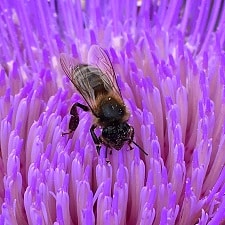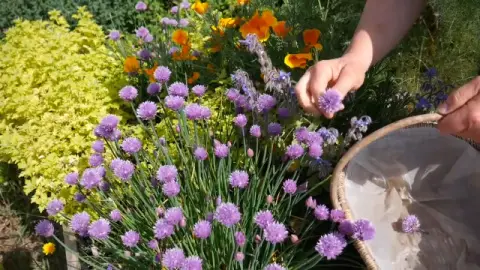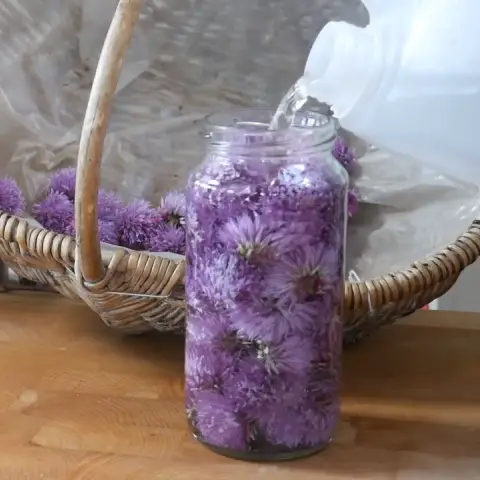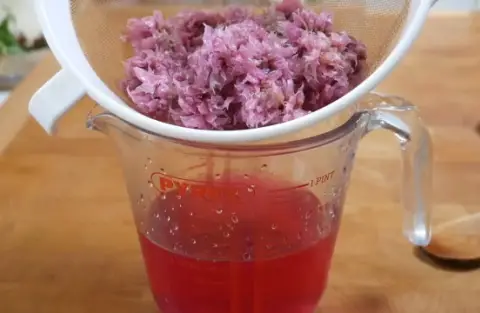How to make Chive Vinegar at home
It is easy, once you know how, to make chive vinegar at home. Flavored vinegar can add an extra dimension to foods. They are ideal to make marinades and dressings to drizzle over salads, garnishes and vegetables. Chive vinegar has a light onion taste and an attractive pink color which adds flavor and color to dressings.
What’s more, this easy recipe is perfect if you like to give homemade gifts at Christmas, birthdays and other celebrations. Simply fill attractive bottles with chive vinegar and decorate with a tie-on label or bow.
Chives are highly useful in the kitchen garden. They add a mild onion taste to dishes like potato salad and lift egg dishes like omelet, quiche or scrambled eggs.

Chives are a perennial herb, meaning they die down in the winter and regrow each spring. Harvest the leaves during summer, chop finely and store in baggies in the freezer for use in the winter months and early spring. Because to the small size of each piece of chopped chive, they do not usually need to be thawed before use in cooking. You could also measure one heaped teaspoon of chopped chives per section in ice cube trays, cover with water and freeze to create herb ice cubes. These can be added to meals like soups, stir-fry meals and casseroles.
Alternatively, they can be dried in a food dehydrator and stored in glass jars in a cool, dark cupboard.
How to grow chives
Chives grow readily from seeds and one seed packet provides enough seeds to grow plenty of plants. I sow a small pinch of seeds into a pot or sowing module and plant out into the garden beds once the young plants are 3-4 inches (7-10cms) tall. The clumps of chives will grow larger each year. Another easy way to have more chive plants is to propagate them by division. In early autumn, lift the clumps, divide them and replant the smaller sections, spacing them about 12 inches (30cms) apart.
Articles on this site may contain affiliate links. As an Amazon Affiliate, we earn from qualifying purchases. Find our full Disclosure Policy here.
Best flowers to make chive vinegar

Gather chive flowers in the morning after the sun has risen, but before the hottest part of the day. The best flowers will have been fully open for a couple of days, but avoid flowers that have gone to seed, so that you can collect the seeds at a later date to sow for more plants.
Prepare the flowers
Wash the flower heads and thoroughly pat dry with a clean tea towel or paper towel or in a salad spinner. Remove as much water as you can because any water left on the chive blossoms can make the vinegar cloudy.

Fill a jar with chive flowers, press down gently, but don’t compact them. Fill to just below the neck of the jar.
Make the infusion

Cover the chive flowers with white vinegar or white wine vinegar and secure the lid onto the jar. Store in a cool, dark place, a cupboard is ideal, for 1 – 6 weeks (or more if desired). This is a key if you want to make chive vinegar at home. Excluding the light give the vinegar its great color.
Remove the chive flowers

Strain the mixture through a non-metallic sieve, jelly bag or muslin cloth. The flowers will break down in the vinegar and often look grey, they is normal. Discard the flowers.
How to store Chive Vinegar

Pour into suitable bottles or jars, secure the lids and store in a cool, dark place.
How to make Chive Vinegar Salad Dressing
- Into a lidded jar, pour one part chive vinegar to two parts edible oil. You can use sunflower, olive oil or any other vegetable oil that you prefer.
- Add a sea salt, course ground black pepper and sugar or honey.
- Add a small amount of mustard, which will act as an emulsifier. If you don’t like the taste of mustard, you could use xanthan gum as an alternative.
- Secure the lid and shake very well to mix the ingredients and shake again immediately before use.
- Stores in the refrigerator for up to one week.
Variations
Now you know how to make chive vinegar at home, you can also try making vinegar with other blossoms. Be sure to check that the blossoms you choose are edible flowers and follow some sensible dos and don’ts of eating flowers.
The flowers of Wild Garlic or Ramsons provide a garlic taste.
Calendula petals give an orange color and slightly peppery-sweet hint.
Alpine pinks (Dianthus) flowers infuse a clove-like flavor.
Fennel flowers offer an anise-flavored hint to the vinegar.
Edible flower safety
Do NOT eat a flower unless you 100% sure you have identified it correctly. Many flowers look very similar; one may be edible, but it’s lookalike could be highly toxic.
Some plants have edible roots, stems or leaves, but not the flowers and likewise, just because the petals are edible, do not assume that the rest of the plant is!
If you suffer from hay fever, be careful about using pollen-heavy edible flowers in your food.
Remove petals from the flower and then discard the pistil and stamens. Also discard the green sepal where appropriate. Some flowers, like elderflowers, are just too small to remove these parts, so they are used whole.
Ensure that any edible flowers have come from a reputable source, preferably an organic supplier or from your own garden where you know what you have or haven’t sprayed on the plants.
Avoid blossoms that have been sprayed with pesticides, selective herbicides or other chemicals. They are likely to have absorbed some of the chemicals, so you won’t want to eat them.
Avoid using flowers from newly purchased plants from garden centers, supermarkets or florists unless they are guaranteed to be organic. Otherwise, plants are likely to have been grown to be attractive, not for their edible qualities and may well have been sprayed with chemicals during the growing process.
If you forage for edible flowers, avoid any that grow next to roads. They are likely to contain contaminants from vehicle fumes.
And also avoid flowers that grow below knee level in gardens that have dogs or for that matter, on pathways that dog-walkers might use.
Further information about how to make chive vinegar at home
Watch the accompanying video on YouTube.
- Romantic garden ideas in June - June 30, 2024
- Mulching, grow with less effort and less watering - June 26, 2024
- Slug Control – How to get rid of slugs in garden - June 26, 2024
